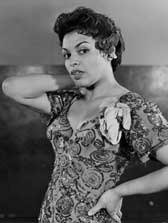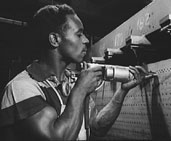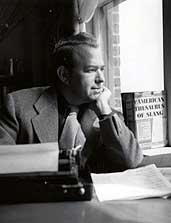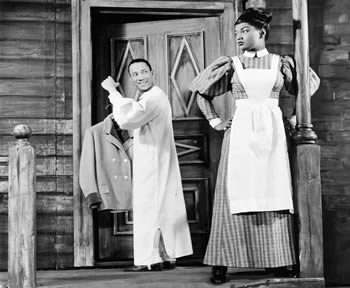Essay
Post-WWII African-American Musicals

Muriel Smith, who played the lead in Hammerstein's "Carmen Jones."
After his triumph with “Oklahoma!,” Oscar Hammerstein II turned to an even more improbable project, something that had preoccupied him for years: a new version of Bizet’s opera “Carmen,” reset in the American South, using the original music with his own lyrics, and a cast composed entirely of black actors. Producer Billy Rose enthusiastically took up the show, hired a first-rate director and designer, and made plans to book the Broadway Theater for the end of 1943.
What Hammerstein and Rose didn’t have was a cast. The vocal and acting demands of the show, “Carmen Jones,” required performers equally adept at opera and musical comedy, but the opportunities for black actors to learn their craft in these venues were woefully inadequate. For years, there hadn’t been enough roles for black talent, so the talent dried up; when roles did become available, there wasn’t enough talent to fill them. Rose engaged a music promoter named John Hammond to round up whatever singers he could find; he discovered his leads in a camera store, on the police force, and working in a navy yard.

Worker during World War II.
“Carmen Jones” was a spectacular hit, opening half a year after “Oklahoma!” It also was the advance guard for a brief but impressive vogue for Broadway musicals that gave new prominence to black performers, sometimes in all-black shows, sometimes integrated with a white company. Broadway had not played host to so many black actors since the early 1920s; the important difference now was that these new shows were written, composed, and produced almost entirely by white artists. Still, the number of black performers in plays and musicals on Broadway in 1946 was more than five times the number before World War II began. In some ways, the increased professional opportunities for African Americans mirrored some slight social changes during the war. Although black army units were still segregated, there was a rise in social consciousness within white America. Some war production jobs, formerly closed to blacks, were opened up; black women also had an opportunity to move out of jobs as domestics into production work; the membership of the NAACP quadrupled; and such polar opposites as Eleanor Roosevelt and Hollywood worked to promote racial tolerance and inclusion between blacks and whites.
On Broadway, the results of this inclusion were mixed, in both style and quality. The trend had a brief prologue in 1940 with Vernon Duke’s simplistically drawn allegory, “Cabin in the Sky,” but it was Hammerstein’s adaptation, with its steamy seductress, obsessed army officer, and macho prizefighter, that really packed a punch. In a kind of bookend to “This Is the Army,” Harold Rome wrote a 1946 tribute to returning veterans, the revue “Call Me Mister.” It contained a musical number called “Red Ball Express,” where a returning black serviceman who ran a successful supply line during the war is denied a job back home, due to prejudice.

Lyricist Yip Harburg
That same season, Harold Arlen and Johnny Mercer explored the turn-of-the-19th century racetrack scene in “St. Louis Woman.” After World War II, Arlen had contributed to two successful all-black Hollywood musicals, “Cabin in the Sky” and “Stormy Weather,” and there seemed to be a market for popular dramatic entertainment with African-American characters. A producer named Edward Gross optioned a play by two shining lights of the Harlem Renaissance, Arna Bontemps and Countee Cullen, and hired them to write the libretto, then asked Harold Arlen and Johnny Mercer to compose the score. It was the first time in Broadway history that black and white writers would collaborate on the text of a musical. However, the felicitous beginning for “St. Louis Woman” quickly went from good to bad to worse. Lena Horne was signed to play the title character, but she soon objected to the depiction of her character as a “painted woman” and quit; indeed, the NAACP complained about the show’s milieu of low-life gamblers and kept women. Horne’s replacement was fired, then reinstated after the cast objected. Worst of all, in a show about bad luck and omens, Cullen died two weeks before rehearsal began. It limped into New York after several out-of-town engagements on March 30, 1946.
Other shows have surmounted worse odds, but “St. Louis Woman” was mostly undone by its attempts to force a complex and unwieldy story into the conventions of the post-Rodgers and Hammerstein musical form. The famed acrobatic dancing Nicholas Brothers were hired to headline, but only the pint-sized Harold had a real part. His brother Fayard had a contrived comic role, and they were given a dancing duel that had no narrative point. The lusty louche atmosphere of East St. Louis was turned into a happy-go-lucky world of musical comedy. What transcended the 113-performance train wreck was the score. Arlen and Mercer gave their romantic leads one of the finest of American standards: “Come Rain or Come Shine,” the most successful song of the least successful show.

Fayard Nicholas and Pearl Bailey in "St. Louis Woman."
In 1949, Kurt Weill and Maxwell Anderson ventured to South Africa for “Lost in the Stars,” the journey of a preacher and his son, which featured the haunting title tune. Weill also wrote the score to 1947’s “Street Scene,” an adaptation of Elmer Rice’s urban panorama. This time, his lyricist was the renowned African-American poet Langston Hughes, who added several black characters. Although Hughes felt his contributions were gradually whittled down, it was the first interracial collaboration on music and lyrics between artists of such magnitude.
The most provocative look at race relations came from the pen of Yip Harburg, who, in 1947’s “Finian’s Rainbow,” turned racism on its head, or more accurately, inside out. The show, which featured lilting words and music by Harburg and Burton Lane, was set in the mythical Deep Southern state of Missitucky. One of the subplots concerns a local racist senator (the papers at the time were filled with the real thing) who is turned into a black man, through a bit of misplaced Celtic magic. The senator’s journey to enlightenment — he is forced to sing along with two black men in a traveling gospel troupe — makes for a wickedly satirical second act, but, sadly, the blackface requirements of the role, whatever the critical intentions, have kept a wonderful score off the boards for nearly four decades.
While the increased employment possibilities for African-American performers were definitely appreciated, the roles themselves — often menials or exotics — were less so, especially since they were written by whites. Facing criticism from black performers and political organizations, writers almost completely stopped creating black roles by the early 1950s. Although they would do so separately, Rodgers and Hammerstein — two men with impeccable liberal credentials — never wrote a part for a black actor during their entire collaboration; that is not a criticism but an observation. The civil rights movement that would so consume the country by the late 1950s was, with a few exceptions in the early 1960s, completely ignored by the Broadway musical. The explosion of shows that brought blacks back to Broadway — on stage — during the late 1940s dissipated as quickly as it had begun. Such a concentration of talent wouldn’t be seen again for nearly 30 years.
Photo credits: Photofest, the Rodgers & Hammerstein Organization, National Archives & Records Administration, and the Library of Congress, and Harburg, and Culver Pictures

